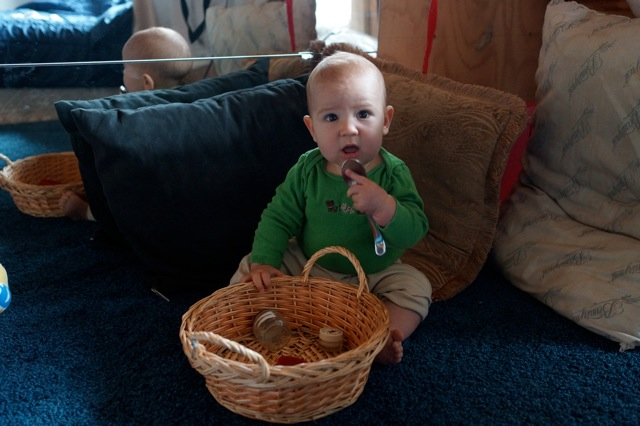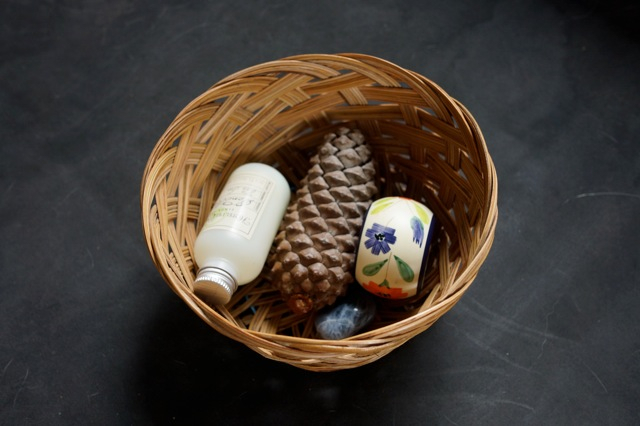The Basket of Known Objects
The Basket of Known Objects is one of the most simple and effective Montessori activities for babies. It promotes exploration, language, sensory development and movement... Best of all, it's 100% FREE!!
As its name implies, this activity requires placing 4-6 safe objects that you find around the house into a child-sized basket. It can be introduced around the age of three months, or when you see that your child is beginning to grasp objects. If your baby can sit up against pillows, you can introduce the basket in a sitting position. Otherwise, you can place it on the floor next to your child and let him turn towards it.
The main purpose of this activity is to help your child explore the objects in his environment before he's crawling; it's like bringing the world to him! While not a formal language activity, you can eventually introduce the names of the objects by conversing casually with your child as he explores. However, first give him ample uninterrupted time to explore the basket and its contents. Now is when you can grab that elusive shower or make dinner!
 Our first basket was too big!
Our first basket was too big!
When I first introduced the activity to Zach, he was more interested in the basket than in the objects. This was a little frustrating until I realized that this is the norm with infants; unlike pre-schoolers (with whom I am accustomed to working), babies will spend a long time just exploring the material and its container before engaging in what we would consider the actual purpose of the activity (of course, this exploration is also purposeful and incredibly important because for them, EVERYTHING is new!).
Our Basket of Known Objects has evolved with Zach's interests (and, I must admit, my creativity). At first, I chose four random objects (a measuring cup, a teaspoon, a baby food jar and a hand cream jar). Note that these are real objects from our environment, not plastic toys. As I moved around the house, I would encounter other items that could be introduced (a bracelet, a small box, a seashell, a coin purse, etc.). Every few days, I would replace one familiar object in the basket with a new item and then offer the basket again. We quickly realized that Zach would zero in on the new object. Every. Single. Time. Try it and see what your baby does!
When Zach began showing interest in crawling at around 6 months of age, I modified the contents of the basket so that they all rolled. This provided lots of opportunity for chasing round objects around the living room!

Now that Zach is eight months old and on the verge of understanding language, I'm preparing a new basket, this time with objects that belong to the same category. I've chosen to start with types of brushes - toothbrush, nail brush, hair brush, and basting brush - since that's what I have around the house. This activity will provide re-enforcement of the word "brush", and will help him understand that within the category "brush" there are many types of brushes.
If you choose to offer this activity to your baby, use common sense to make sure all the objects in the basket are safe. Tightly screw the caps on small bottles and check them often (some people even glue them on); avoid objects that can poke (especially before the child develops good coordination); if you are offering an object made out of glass, don't leave baby unattended and make sure he's exploring on a soft surface away from walls. If you choose the objects with care, you can leave your baby exploring on his own for as long as he's interested (sometimes Zach would work with his basket for over 20 minutes).
Have you made a Basket of Known Objects for your baby? Do you have any suggestions for parents who want to try this activity with their child? Please share your ideas or experiences in the comments!
As its name implies, this activity requires placing 4-6 safe objects that you find around the house into a child-sized basket. It can be introduced around the age of three months, or when you see that your child is beginning to grasp objects. If your baby can sit up against pillows, you can introduce the basket in a sitting position. Otherwise, you can place it on the floor next to your child and let him turn towards it.
The main purpose of this activity is to help your child explore the objects in his environment before he's crawling; it's like bringing the world to him! While not a formal language activity, you can eventually introduce the names of the objects by conversing casually with your child as he explores. However, first give him ample uninterrupted time to explore the basket and its contents. Now is when you can grab that elusive shower or make dinner!
 Our first basket was too big!
Our first basket was too big!When I first introduced the activity to Zach, he was more interested in the basket than in the objects. This was a little frustrating until I realized that this is the norm with infants; unlike pre-schoolers (with whom I am accustomed to working), babies will spend a long time just exploring the material and its container before engaging in what we would consider the actual purpose of the activity (of course, this exploration is also purposeful and incredibly important because for them, EVERYTHING is new!).
Our Basket of Known Objects has evolved with Zach's interests (and, I must admit, my creativity). At first, I chose four random objects (a measuring cup, a teaspoon, a baby food jar and a hand cream jar). Note that these are real objects from our environment, not plastic toys. As I moved around the house, I would encounter other items that could be introduced (a bracelet, a small box, a seashell, a coin purse, etc.). Every few days, I would replace one familiar object in the basket with a new item and then offer the basket again. We quickly realized that Zach would zero in on the new object. Every. Single. Time. Try it and see what your baby does!
When Zach began showing interest in crawling at around 6 months of age, I modified the contents of the basket so that they all rolled. This provided lots of opportunity for chasing round objects around the living room!

Now that Zach is eight months old and on the verge of understanding language, I'm preparing a new basket, this time with objects that belong to the same category. I've chosen to start with types of brushes - toothbrush, nail brush, hair brush, and basting brush - since that's what I have around the house. This activity will provide re-enforcement of the word "brush", and will help him understand that within the category "brush" there are many types of brushes.
If you choose to offer this activity to your baby, use common sense to make sure all the objects in the basket are safe. Tightly screw the caps on small bottles and check them often (some people even glue them on); avoid objects that can poke (especially before the child develops good coordination); if you are offering an object made out of glass, don't leave baby unattended and make sure he's exploring on a soft surface away from walls. If you choose the objects with care, you can leave your baby exploring on his own for as long as he's interested (sometimes Zach would work with his basket for over 20 minutes).
Have you made a Basket of Known Objects for your baby? Do you have any suggestions for parents who want to try this activity with their child? Please share your ideas or experiences in the comments!
Categories
- 3-6 (8)
- 6-9 (26)
- 9-12 (8)
- Positive Discipline (2)
- Conscious Parenting (12)
- Montessori Curriculum (9)
- Preparation of the Adult (14)
- Preparation of the Environment (11)
- Montessori Principles (11)
- Montessori Homeschooling (20)
- Language Arts (3)
- Math (3)
- Geography (2)
- Biology (1)
- History (2)
- Practical Life (1)
- Montessori Stories (4)

7 comments
Leave a comment